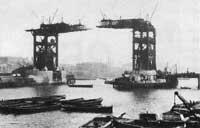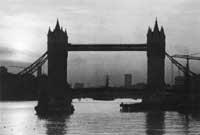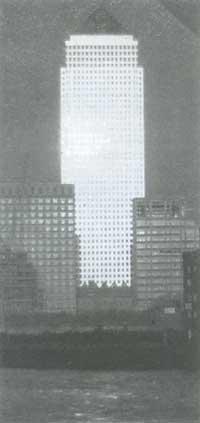Tower Bridge: side by side bridge
1994/06/01 Kaltzada, Pili - Elhuyar Zientziaren Komunikazioa Iturria: Elhuyar aldizkaria
It is not true that he was born with City, but this is what pattern Chris Stevens told us. The bridge called Tower Bridge corresponds to the British capital as the Eiffel Tower Paris. The story is also the size of the symbol.
The social and economic life of London has been structured for years around Tower Bridge. Before its creation, a ferry crossed the bridge layout from the Horselaydown Step to the northern corners. At that time it was called “The Hole of the Dead Man” and, once again, history will tell us why: Bart Hospital took the corpses he needed for the investigation on this ferry.
Elizabeth II Bridge opened in Danford in 1991, but until then Tower Bridge was the only one downstream of the London Bridge.
But we go to the point. Before seeing the bridge, the inhabitants of London had many fights. With the first project, the incidents began.

The construction of Tower Bridge was defended from the beginning by entrepreneurs and motorists with land businesses (especially East London) in the hope that the bridge greatly improved transport conditions. It should be noted that in the 1880s there were about a million inhabitants in this region, a third of the population of London. While roads and bridges were being built in the West, while eastern transport was being carried out by car, and if one wanted to cross the river, the only step was the London Bridge, although it was the longest.
The powerful businessmen of the shipyards who rose up against the construction of the bridge complained about the changes that Tower Bridge would bring about. It was thought that the main trade axis of the British Empire would be endangered, as coal from the North and products from the Remote Colonies were transported from that time. In the opinion of the shareholders and owners of Untzioleta, the construction of the new bridge would significantly reduce the traffic of large ships or, what is the same, the business network of great interest.
Therefore, a difficult and relevant decision was delegated to Parliament. The commission was assumed by the association The Bridge House States. XII. In the eighteenth century King John ordered the same association to build the London Bridge, and, despite the opinions, Tower Bridge is the main architect of the world.
The advisors of this group had to analyze more than 50 pre-projects. The Parliament established a single general and almost unique condition to defend the interests of the shipowners: the bridge had to allow the city a navigable channel of 50 by 40 meters in length.
In 1878 Horace Jones, designer of the official buildings of the City, discovered the concept of what would be Tower Bridge. Apparently in the Netherlands, he presented a design of two towers, which is the only thing that stands on this initial idea.
In the river, between the two towers mentioned, the intrinsic interest to the new invention that offered the step that would rise with hydraulic force: on the one hand, a suspension bridge and on the other, based on the vascular system. In practice, however, the obstacle was pursued by Jones for the obstacle, until he got the help of engineer John Wolfe.
From the beginning Wolf saw clearly that the brick structure was not going to be able to meet the requirements of the threads, and they began to design the steel bridge. Therefore, the granite of the towers that can be seen today does not have a function of its own in the structure of the bridge, since it is only a configuration.
To locate the foundations, once the bases of the banks of the river were placed, they worked in chambers that were submerged in the subsoil, removing the mud. The cameras were carried to their flotation line and later, by a pump, were brought back to surface. In total 10 workers died in those tasks, although less than expected in such a complicated project.
When building the most complex structure of the time, designers had to take advantage of all kinds of advances. Thanks to a new tool designed by engineer James Tuit, the mechanism of lifting the Bridge was launched faster than expected.
The structure of the bridge allows, if necessary, easy inspection of the supports that make up the base, which is, logically, an appreciable help in repair tasks. We had the opportunity to talk to Chris Stevens, the man in charge of the bridge, and he told us that 30 years ago they opened the decks to explore the lower structures. At first glance they realized their good appearance.
But the victory of the years has found a new rival in recent times: the current heavy traffic. Trucks carrying more than 17 tons are prohibited from passing Tower through Bridge, but as Stevens told us the ban is not being properly enforced, so it is very common to review the state of the bridge.
The hydraulic force was a good source of energy to carry out the work of Tower Bridge, but from the point of view of efficiency they realized that it had its cons. Although the steam engines at the time gave strength, the process of lifting the bridge was carried out very slowly, which seriously affected naval traffic.
To cope with the problem, large steam engines were installed on the southern bank of the Tamesi River, from where water was pumped into pressure chambers with large weights. When the water level rose, the weights were lifted and a valve on one side closed the water when the machines were standing. When energy was needed, a valve was opened from the lower part of the chamber and the water affected the hydraulic lifting system with a lot of pressure. Thus, the bridge could be opened in a single minute.

Another remarkable feature of Tower Bridge was the fact that it had duplicated the necessary machinery for the opening of the bridge. The steam was formed in two boilers, then sent by two special pumps and finally reached the two drive chambers of the collection mechanisms. The truth is that a simpler structure could easily carry out the work of the double machinery, but so it tried to avoid errors and breaks. And get it.
The hydraulic force was also used to operate elevators for high pedestrian crossings, but before World War I they had to close them for murders, robberies, etc. that were produced there.
At its best, the bridge opened 6,000 times a year and in total there were a hundred workers who took care to supply coal, “feed” machinery and collection mechanisms.
However, the decline in ports that began after World War II has far removed that era of happiness and thus the economic influence of Tower Bridge.
In 1972 the City Council of London commissioned the renewal of the mechanisms that make the bridge rise. Diesel has replaced steam which was the only source of energy, oil water in hydraulic systems and traffic is currently regulated by computer.
It should not be said that the current Tower Bridge has nothing to do with the previous one, and as its commercial importance is reduced, it is increasingly associated with the tourist interest. In 1982 the exhibition organized by the City of London was visited by thousands of people, perhaps without knowing that they were very close to the History of the City.
But Tower Brigde, as we know, was not made for visitors, much less. The traffic currently unfolding under it has changed dramatically, but the initial structure remains there. The fatigue of engineers Horace Jones or John Wolfe, advisors to The Bridge House Estates, seems not to have been useless.

Gai honi buruzko eduki gehiago
Elhuyarrek garatutako teknologia




